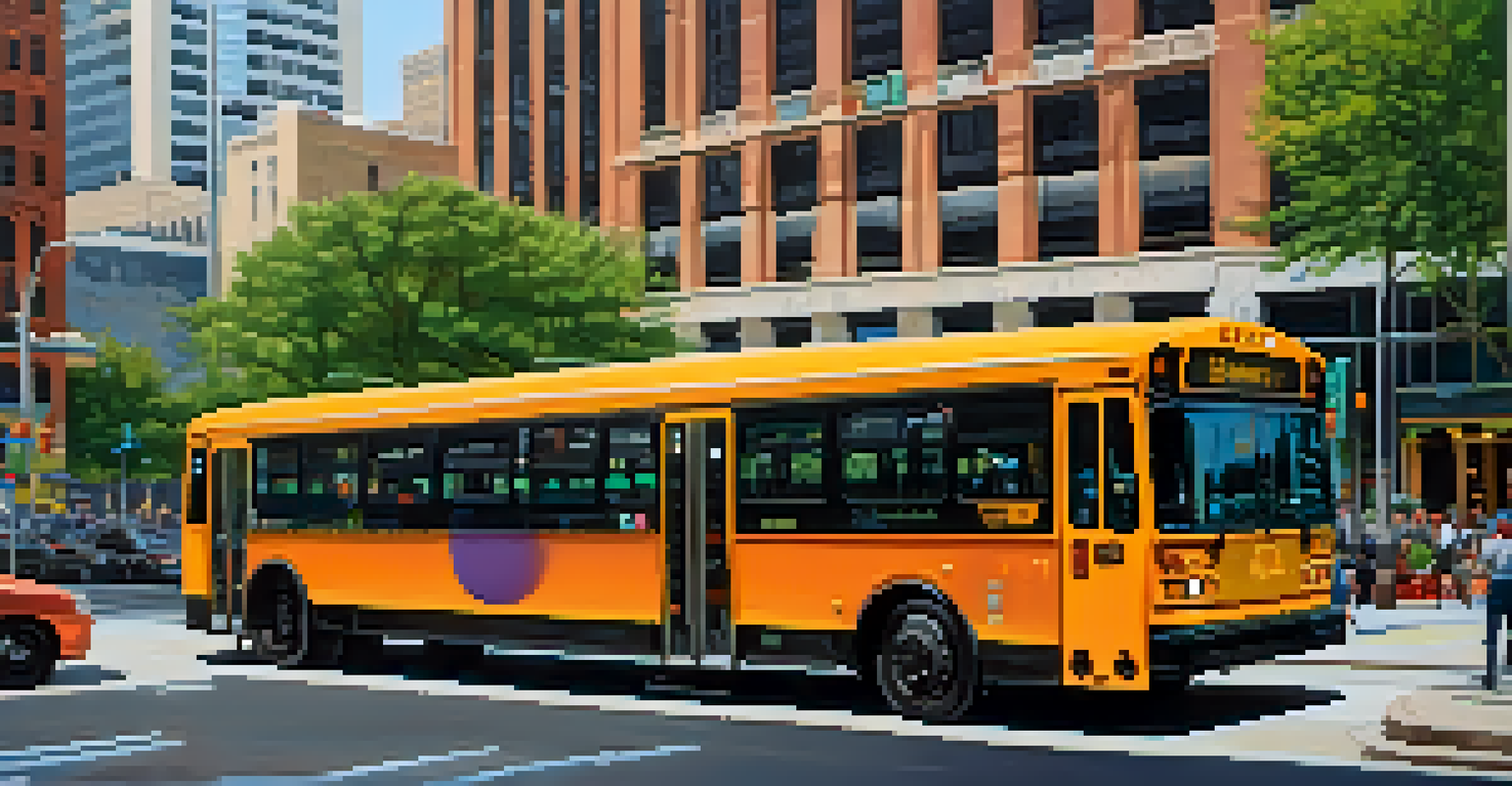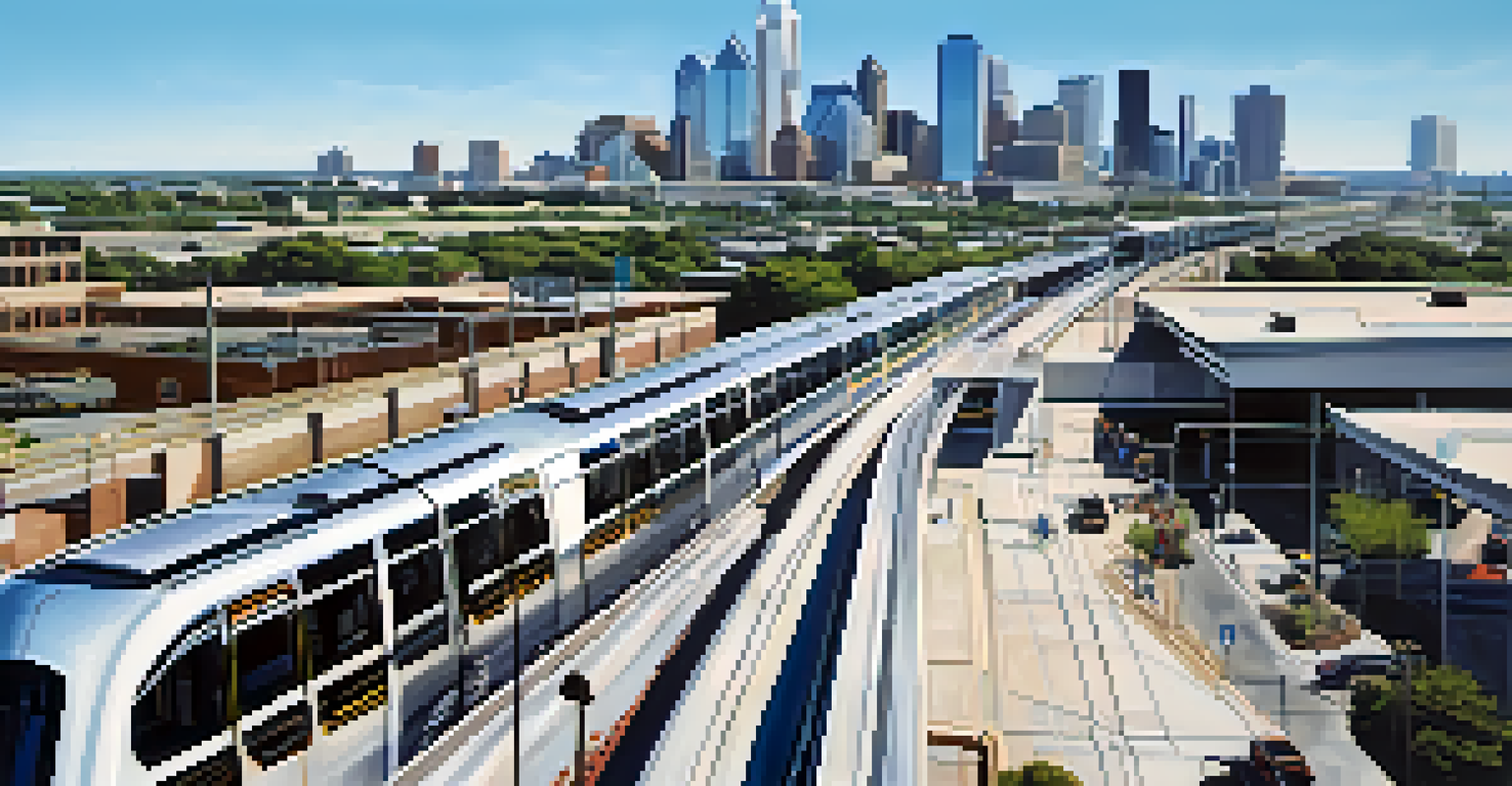Key Milestones in Dallas Public Transportation Development

The Birth of Public Transit in Dallas: Early Beginnings
Dallas' journey into public transportation began in the late 19th century with the advent of streetcars. The first horse-drawn streetcar line opened in 1881, connecting downtown to nearby neighborhoods. This innovation marked a pivotal point, as it made commuting easier for the growing population.
Public transportation is the backbone of a city. It's not just about moving people; it's about connecting communities and fostering economic growth.
As the city expanded, so did the streetcar network, transforming from horse-drawn to electric streetcars by the early 1900s. This shift not only improved efficiency but also encouraged urban development, allowing residents to access areas further from the city center. Streetcars became a vital part of daily life, shaping the urban landscape.
By the 1930s, Dallas had one of the largest streetcar systems in the country, boasting over 200 miles of track. However, as automobiles became more popular, the streetcar system faced decline. This transition illustrated the challenges of adapting public transit to evolving transportation preferences.
The Rise of Buses: A New Era of Flexibility
As the streetcar system waned, buses emerged in the mid-20th century as a more flexible and cost-effective mode of transportation. In 1949, the Dallas Transit System began offering bus services, complementing the dwindling streetcar lines. This transition marked a significant pivot in how residents navigated the city.

Buses provided the ability to reach areas without established streetcar routes, making public transport more accessible. The introduction of new routes and schedules catered to the needs of a rapidly growing population, further embedding public transportation into the daily lives of Dallas residents. This adaptability was key to the system's survival.
Dallas Transit Evolved Over Time
From horse-drawn streetcars to the DART light rail system, Dallas public transit has continuously adapted to meet the needs of its growing population.
By the 1970s, the bus network had expanded significantly, but it faced its own set of challenges, such as funding and competition from private vehicles. Nevertheless, the flexibility of bus services allowed Dallas to maintain a level of public transportation infrastructure as the city evolved.
The Launch of DART: A Major Transformation
In 1983, the Dallas Area Rapid Transit (DART) system was established, fundamentally changing the public transportation landscape. DART aimed to provide a more integrated and efficient network, combining bus and rail services to serve the greater Dallas area. This shift was crucial in promoting public transit as a viable alternative to driving.
The future of public transit lies in integrating technology and sustainability to create systems that are efficient and accessible to all.
The first light rail line opened in 1996, connecting downtown Dallas to nearby suburbs and effectively expanding the reach of public transportation. This development not only improved transit options but also spurred economic growth along the rail corridors, illustrating the positive impact of well-planned public transit systems.
DART has continued to grow, adding new lines and services to meet the needs of a diverse population. Its commitment to improving public transport accessibility and reliability has made it a model for other cities looking to enhance their own transit systems.
Advancements in Technology: Integrating Smart Solutions
In recent years, technology has played a pivotal role in reshaping public transportation in Dallas. The introduction of mobile apps, real-time tracking, and digital payment systems has made commuting more convenient for riders. These technologies have improved the overall experience, making public transit a more attractive option.
DART's implementation of smart technology includes features like electronic fare collection and real-time arrival information. Such innovations not only streamline operations but also enhance the user experience, encouraging more residents to utilize public transportation. This tech-savvy approach reflects a modernized vision for public transit.
Technology Enhances Commuting
Innovations like mobile apps and real-time tracking have transformed the public transportation experience in Dallas, making it more user-friendly and efficient.
As technology continues to evolve, Dallas is poised to incorporate even more advancements into its public transportation system. The goal is to create a seamless and efficient transport network that meets the demands of a growing urban population while reducing congestion and environmental impact.
The Role of Public Transit in Urban Development
Public transportation is not just about getting from point A to point B; it plays a crucial role in urban development. The growth of DART has stimulated economic activity in areas with accessible transit options, leading to increased property values and new business opportunities. This relationship demonstrates how public transit can drive urban revitalization.
As neighborhoods become more transit-oriented, they attract residents looking for convenience and accessibility. This trend has led to the development of mixed-use spaces that combine residential, retail, and entertainment options near transit stations. Such designs promote a walkable lifestyle, reducing reliance on personal vehicles.
Moreover, public transit contributes to sustainability efforts by decreasing traffic congestion and lowering carbon emissions. As cities like Dallas prioritize public transportation, they are also investing in a more sustainable future, proving that effective transit systems are essential for healthy urban environments.
Challenges Ahead: Adapting to Changing Needs
Despite the progress made, Dallas public transportation faces several challenges that require ongoing attention. Issues like funding, maintaining infrastructure, and adapting to changing demographics are crucial for the system's long-term success. Addressing these challenges is essential for ensuring that public transit remains a viable option for all residents.
The COVID-19 pandemic highlighted the importance of flexibility in public transportation. With changes in commuting patterns and increased remote work, transit systems must adapt to meet evolving needs. This dynamic environment requires innovative solutions to attract riders back to public transit while ensuring safety.
Public Transit Fuels Urban Growth
Accessible public transportation has stimulated economic development and sustainability in Dallas, contributing to urban revitalization and community connectivity.
Additionally, as Dallas continues to grow, the demand for efficient public transportation will increase. Planning for future expansion, improving service frequency, and enhancing connectivity will be vital in meeting the needs of a diverse population and ensuring that public transit remains a cornerstone of the city's infrastructure.
Future Vision: The Next Steps for Dallas Public Transportation
Looking ahead, the future of Dallas public transportation appears promising yet challenging. Initiatives to expand the light rail network and improve bus services are underway, aiming to connect more communities and enhance accessibility. These efforts are essential for fostering a more integrated transit system that can serve a growing population effectively.
Sustainability will also be a key focus in future planning. Dallas aims to incorporate green technologies and energy-efficient practices into its transportation systems. By prioritizing sustainability, the city not only addresses environmental concerns but also positions itself as a forward-thinking urban center.

Ultimately, the vision for Dallas public transportation is one of inclusivity and innovation. By continuing to adapt and evolve, the city can create a transportation network that meets the needs of all residents, fostering a vibrant, connected community for years to come.